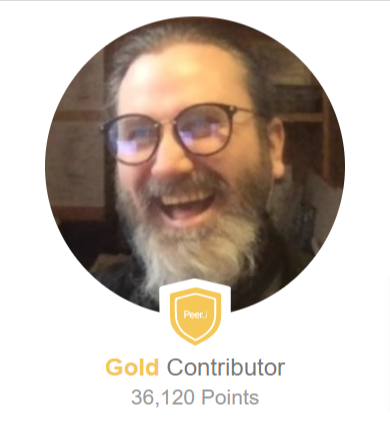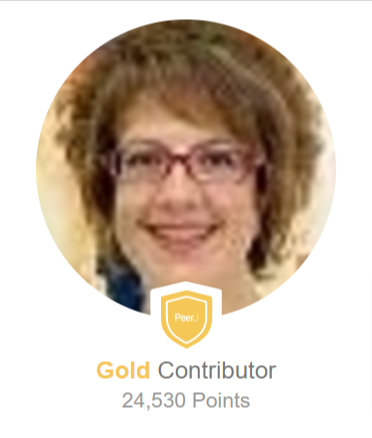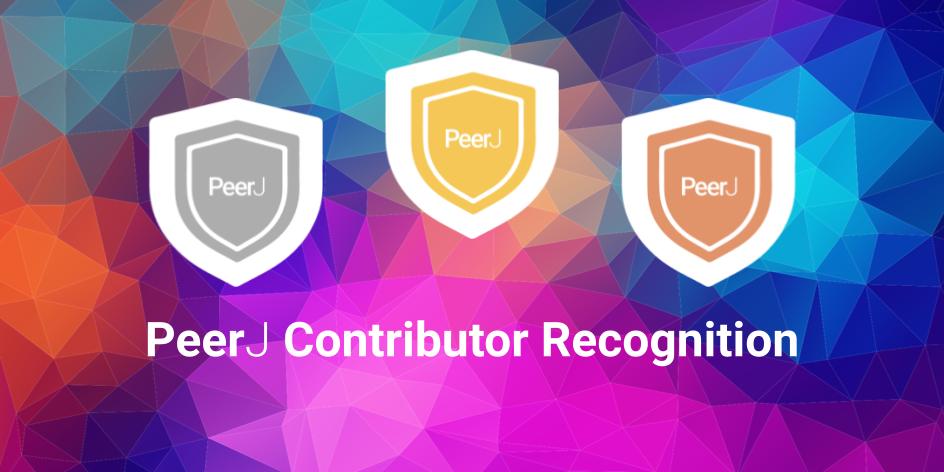Many of the contributions made by researchers to the peer review process can go unrecognized and be underappreciated. As a publisher of peer-reviewed journals we are acutely aware of how vital the contributions from the many communities who choose to work with us are: our content is written by researchers and reviewed for scientific soundness by thousands of volunteer reviewers, all overseen by our fantastic Academic Editors and Section Editors. As thanks, we provide APC discounts to our Editorial Board Members and on-time reviewers; and via the PeerJ Awards program and our series of blog interviews we highlight the research and achievements of our contributors.
Since PeerJ launched we have also awarded Contribution Points for key contributions to the peer-review process, and particularly for actions we believe make science more open. These include:
- Acting as Academic Editor for a submission
- Authoring a published article – with additional points if you choose to publish your peer review history
- Reviewing an article – with more points for signed reviews
Today we are re-launching Contribution Points as the first part of a larger ‘Contributor Recognition’ program.
Recognizing Contributions from the last 8 years of publishing
Over the last 8 years of publishing, our contributors have generated over a million contribution points; rest assured, these are not going anywhere! From today, we have introduced badging for our most prolific contributors, as follows:
- Three Gold Contributors who have accrued between 20,000 and 50,000 points
- Twelve Silver Contributors who have accrued between 10,000 and 20,000 points
- 53 Bronze Contributors who have accrued between 5,000 and 10,000 points
These are significant achievements:
- Gold Contributors are in the top 0.1% of Contributors
- Silver Contributors are in the top 0.3% of Contributors
- Bronze Contributors are in the top 1% of Contributors
Contributors who have achieved these awards, which are permanent, now have clear badging on their profiles. We will be emailing our Gold, Silver and Bronze contributors with our thanks and a digital certificate, as well as thanking them publicly on social media.
To give some context for what 20,000 points mean, we wanted to highlight and thank our three Gold Contributors, and their contributions to PeerJ.
PeerJ’s Gold Contributors
 Joseph Gillespie – 36,120 Contribution Points
Joseph Gillespie – 36,120 Contribution Points
Joseph Gillespie – Assistant Professor at the University of Maryland – is an evolutionary biologist with broad interests in organismal and molecular evolution. The major focus of his current research is deciphering the mechanisms by which obligate intracellular species of Rickettsiales (Alphaproteobacteria) invade, survive and replicate within eukaryotic cells.
Since joining the PeerJ Life & Environment Editorial Board in 2017, Joseph has handled over 440 papers for the journal. The papers he has accepted for publication have, so far, accrued 1284 citations and been viewed over 430,000 times. We are greatly indebted to Joseph’s contribution to PeerJ.
 Vladimir N. Uversky – 27,530 Contribution Points
Vladimir N. Uversky – 27,530 Contribution Points
Vladimir Uversky is Professor at the Department of Molecular Medicine of University of South Florida, College of Medicine, and Visiting Professor at Moscow Institute of Physics and Technology. Vladimir carries out research into intrinsically disordered proteins and analyzes protein folding and misfolding processes.
Vladimir was one of our earliest board members, joining just a few weeks after we launched. Since then he has handled almost 300 submissions; those that were accepted for publication have generated 771 citations and over 315,000 views on the PeerJ site. Vladimir also authored PeerJ article #2 on our first day of publishing – since which he has published another 6 articles including publishing the full peer review history, garnering another 945 points. We want to thank Vladimir for his support since the earliest days of PeerJ and his continued contributions since.
 María Ángeles Esteban – 24,530 Contribution Points
María Ángeles Esteban – 24,530 Contribution Points
María Ángeles Esteban is a Professor at Universidad de Murcia where she carries out research in Cell Biology, Immunology and Biotechnology. She is the head of the Immunobiology for Aquaculture Team at Murcia, where previously she was also Vice Chancellor.
Maria joined the editorial board of PeerJ Life & Environment in 2014, and since then has handled 265 submissions to the journal. The papers she has accepted for publication have, so far, accrued 1543 citations and been viewed over 400,000 times. We are truly thankful to Maria for her contribution to PeerJ.
We are also very lucky to have twelve Silver Contributors and 43 Bronze Contributors to whom we also extend our sincerest thanks.
 PeerJ Silver Contributors
PeerJ Silver Contributors
| Pedro Silva | Universidade Fernando Pessoa | 18,640 |
| Jafri Abdullah | Universiti Sains Malaysia | 17,790 |
| Robert Toonen | University of Hawaii at Manoa | 17,170 |
| James Reimer | University of the Ryukyus | 17,135 |
| Antonio Palazón-Bru | Miguel Hernández University | 16,505 |
| Donald Kramer | McGill University | 12,905 |
| Justin Keogh | Bond University | 12,180 |
| John Hutchinson | The Royal Veterinary College | 11,655 |
| Michael Wink | Ruprecht-Karls-Universität Heidelberg | 11,655 |
| Paul Tulkens | Université catholique e Louvain | 11,565 |
| Yuriy Orlov | I.M Sechenov First Moscow State Medical University | 10,975 |
| Todd Anderson | Texas Tech University | 10,875 |
| Andrew Gray | University of Otago | 10,080 |
 PeerJ Bronze Contributors
PeerJ Bronze Contributors
| David Roberts | University of Kent | 9,870 |
| Bao-Liang Zhong | Wuhan Mental Health Center | 9,595 |
| Virginia Abdala | CONICET | 9,515 |
| Andrew Farke | Raymond M. Alf Museum of Paleontology | 9,325 |
| Stuart Pimm | Duke University | 9,265 |
| Mark Young | University of Edinburgh | 8,850 |
| Gwyn Gould | University of Strathclyde | 8,690 |
| Ann Hedrick | University of California, Davis | 8,605 |
| Jennifer Vonk | Oakland University | 8,345 |
| Rogerio Sotelo-Mundo | Centro de Investigación en Alimentación y Desarrollo, A.C. | 8,190 |
| Dezene Huber | University of Northern British Columbia | 8,030 |
| Keith Crandall | George Washington University | 7,890 |
| Victoria Sosa | Instituto de Ecologia AC | 7,820 |
| Daniela Foti | University “Magna Græcia” of Catanzaro, Italy | 7,410 |
| Claus Wilke | University of Texas at Austin | 7,395 |
| Aslı Suner | Ege University | 7,385 |
| Kenneth De Baets | Friedrich-Alexander Universität Erlangen-Nürnberg | 7,380 |
| Tatiana Tatarinova | University of La Verne | 7,140 |
| John Measey | Stellenbosch University | 7,090 |
| Tjeerd Boonstra | University of Maastricht | 6,915 |
| Patricia Gandini | Universidad Nacional de la Patagonia Austral | 6,810 |
| Budiman Minasny | The University of Sydney | 6,795 |
| Bob Patton | University of Surrey | 6,720 |
| Konstantinos Kormas | University of Thessaly | 6,695 |
| Mark Costello | Høgskolen i Nord-Trøndelag | 6,680 |
| Shawn Gomez | University of North Carolina at Chapel Hill | 6,575 |
| Joao Rocha | Universidade Federal de Santa Maria | 6,555 |
| Kenta Nakai | The University of Tokyo | 6,245 |
| Walter de Azevedo Jr. | Pontifical Catholic University of Rio Grande do Sul-Brazil. | 6,215 |
| Gerard Lazo | United States Department of Agriculture | 6,170 |
| Paolo Giordani | University of Genoa | 6,155 |
| Marcio Pie | Universidade Federal do Paraná, Brazil. | 6,065 |
| Lydia Hopper | Lincoln Park Zoo | 6,060 |
| Anastazia Banaszak | Universidad Nacional Autónoma de México | 6,035 |
| Valeria Souza | Universidad Nacional Autónoma de México | 5,995 |
| Maria Cristina Albertini | University of Urbino | 5,960 |
| Elena Papaleo | Danish Cancer Society Research Center, Copenhagen, Denmark | 5,955 |
| Ilaria Negri | Catholic University of Milan | 5,940 |
| Sebastian Ventura | University of Cordoba | 5,870 |
| Fabien Knoll | ARAID | 5,800 |
| Ruslan Kalendar | University of Helsinki | 5,785 |
| Mikhail Gelfand | Kharkevich Institute for Information Transmission Problems | 5,690 |
| Offer Erez | Soroka University Medical Center, Faculty of Health Sciences, Ben Gurion University of the Negev | 5,685 |
| Scott Edwards | Harvard University | 5,635 |
| Nigel Yoccoz | UiT The Arctic University of Norway | 5,545 |
| Blanca Landa | Institute for Sustainable Agriculture-CSIC | 5,535 |
| Robert Winkler | CINVESTAV Unidad Irapuato | 5,490 |
| Mario Alberto Flores-Valdez | Centro de Investigación y Asistencia en Tecnología y diseño del Estado de Jalisco, A.C. | 5,410 |
| Wenfa Ng | Citizen scientist, Novena, Singapore | 5,390 |
| Tsung-Min Hung | National Taiwan Normal University | 5,320 |
| Joseph Pawlik | UNCW | 5,220 |
| Abhishek Kumar | Institute of Bioinformatics (IOB), Bangalore. India | 5,115 |
| Stephen Macknik | SUNY Downstate Health Sciences University | 5,080 |
Without these contributors and countless others we would never have been able to publish the 12,000+ articles since we launched. We are grateful to all of our contributors for making PeerJ what it is today!
Contributor recognition in 2021 and beyond
As contributors move into a new level they will receive the appropriate profile badge automatically, and we’ll be sure to send our thanks and a certificate directly to each contributor; Gold Contributors will also be featured on the blog. We will also be adding new contributor awards at 50,000 and 100,000 points – more information on that soon!
We intend to add new allocations for other contributions, plus we will also introduce new contribution awards. These will be for the top contributor in each section of PeerJ Life & Environment; new Section Editor awards; the top contributors to PeerJ Computer Science and our five Chemistry journals; and top reviewer awards.
We appreciate that this is just a small step towards providing greater recognition to our contributors. We have some more plans in the pipeline and you’ll be hearing more about them soon.
As always, we’d love to hear from you – our contributors – about what else you think we could do. We can’t promise to enact every suggestion, but we can certainly promise to consider and respond to each one. Please get in contact with your ideas.

